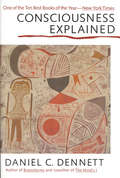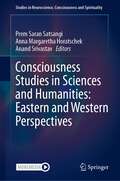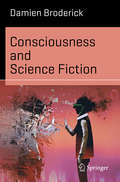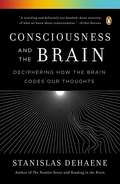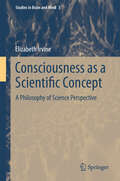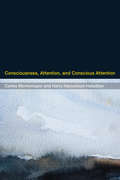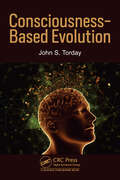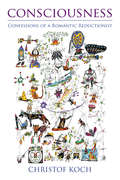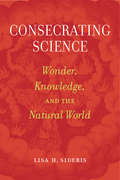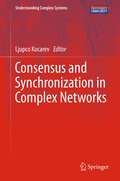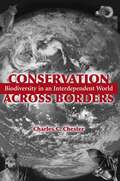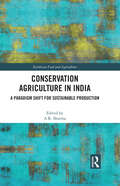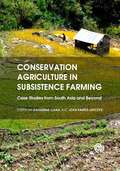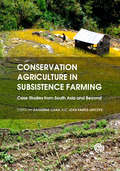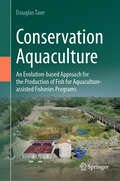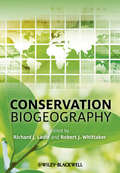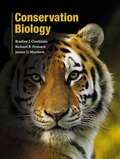- Table View
- List View
Consciousness Explained
by Daniel C. Dennett"Brilliant...as audacious as its title....Mr. Dennett's exposition is nothing short of brilliant." --George Johnson, New York Times Book Review Consciousness Explained is a a full-scale exploration of human consciousness. In this landmark book, Daniel Dennett refutes the traditional, commonsense theory of consciousness and presents a new model, based on a wealth of information from the fields of neuroscience, psychology, and artificial intelligence. Our current theories about conscious life-of people, animal, even robots--are transformed by the new perspectives found in this book.
Consciousness Studies in Sciences and Humanities: Eastern and Western Perspectives (Studies in Neuroscience, Consciousness and Spirituality #8)
by Anand Srivastav Prem Saran Satsangi Anna Margaretha HoratschekThis book presents consciousness models from Eastern and Western perspectives that accommodate current scientific research in the natural sciences and humanities, from neurological experiments through philosophical enquiries to spiritual approaches. It offers up to date research from key disciplines in consciousness studies ranging from neurology, quantum mechanics, algorithmic science, mathematics, and astrophysics to literary studies, philosophy, and (comparative) theology. The volume examines the dichotomy between Western and Eastern perceptions of consciousness – where consciousness is perceived as brain activity by Western scientists, and as a divine presence by various religions, especially in the East. The essays contextualize each other and reciprocally illuminate the potential and limits of the respective approaches. The texts aim at a transdisciplinary and transcultural exchange of ideas in consciousness studies and address a readership from interested lay-readers to experts of the field. The volume is of interest to researchers of consciousness studies.
Consciousness and Mental Life
by Daniel N. RobinsonIn recent decades, issues that reside at the center of philosophical and psychological inquiry have been absorbed into a scientific framework variously identified as "brain science," "cognitive science," and "cognitive neuroscience." Scholars have heralded this development as revolutionary, but a revolution implies an existing method has been overturned in favor of something new. What long-held theories have been abandoned or significantly modified in light of cognitive neuroscience? Consciousness and Mental Life questions our present approach to the study of consciousness and the way modern discoveries either mirror or contradict understandings reached in the centuries leading up to our own. Daniel N. Robinson does not wage an attack on the emerging discipline of cognitive science. Rather, he provides the necessary historical context to properly evaluate the relationship between issues of consciousness and neuroscience and their evolution over time. Robinson begins with Aristotle and the ancient Greeks and continues through to René Descartes, David Hume, William James, Daniel Dennett, John Searle, Richard Rorty, Hilary Putnam, and Derek Parfit. Approaching the issue from both a philosophical and a psychological perspective, Robinson identifies what makes the study of consciousness so problematic and asks whether cognitive neuroscience can truly reveal the origins of mental events, emotions, and preference, or if these occurrences are better understood by studying the whole person, not just the brain. Well-reasoned and thoroughly argued, Consciousness and Mental Life corrects many claims made about the success of brain science and provides a valuable historical context for the study of human consciousness.
Consciousness and Mental Life
by Daniel N. RobinsonIn recent decades, issues that reside at the center of philosophical and psychological inquiry have been absorbed into a scientific framework variously identified as "brain science," "cognitive science," and "cognitive neuroscience." Scholars have heralded this development as revolutionary, but a revolution implies an existing method has been overturned in favor of something new. What long-held theories have been abandoned or significantly modified in light of cognitive neuroscience? Consciousness and Mental Life questions our present approach to the study of consciousness and the way modern discoveries either mirror or contradict understandings reached in the centuries leading up to our own. Daniel N. Robinson does not wage an attack on the emerging discipline of cognitive science. Rather, he provides the necessary historical context to properly evaluate the relationship between issues of consciousness and neuroscience and their evolution over time. Robinson begins with Aristotle and the ancient Greeks and continues through to René Descartes, David Hume, William James, Daniel Dennett, John Searle, Richard Rorty, Hilary Putnam, and Derek Parfit. Approaching the issue from both a philosophical and a psychological perspective, Robinson identifies what makes the study of consciousness so problematic and asks whether cognitive neuroscience can truly reveal the origins of mental events, emotions, and preference, or if these occurrences are better understood by studying the whole person, not just the brain. Well-reasoned and thoroughly argued, Consciousness and Mental Life corrects many claims made about the success of brain science and provides a valuable historical context for the study of human consciousness.
Consciousness and Science Fiction (Science and Fiction)
by Damien BroderickScience fiction explores the wonderful, baffling and wildly entertaining aspects of a universe unimaginably old and vast, and with a future even more immense. It reaches into that endless cosmos with the tools of rational investigation and storytelling. At the core of both science and science fiction is the engaged human mind--a consciousness that sees and feels and thinks and loves. But what is this mind, this aware and self-aware consciousness that seems unlike anything else we experience? What makes consciousness the Hard Problem of philosophy, still unsolved after millennia of probing? This book looks into the heart of this mystery - at the science and philosophy of consciousness and at many inspiring fictional examples - and finds strange, challenging answers.The book's content and entertaining style will appeal equally to science fiction enthusiasts and scholars, including cognitive and neuroscientists, as well as philosophers of mind. It is a refreshing romp through the science and science fiction of consciousness.
Consciousness and the Brain: Deciphering How the Brain Codes Our Thoughts
by Stanislas DehaeneA breathtaking look at the new science that can track consciousness deep in the brain How does our brain generate a conscious thought? And why does so much of our knowledge remain unconscious? Thanks to clever psychological and brain-imaging experiments, scientists are closer to cracking this mystery than ever before. In this lively book, Stanislas Dehaene describes the pioneering work his lab and the labs of other cognitive neuroscientists worldwide have accomplished in defining, testing, and explaining the brain events behind a conscious state. We can now pin down the neurons that fire when a person reports becoming aware of a piece of information and understand the crucial role unconscious computations play in how we make decisions. The emerging theory enables a test of consciousness in animals, babies, and those with severe brain injuries. A joyous exploration of the mind and its thrilling complexities, Consciousness and the Brain will excite anyone interested in cutting-edge science and technology and the vast philosophical, personal, and ethical implications of finally quantifying consciousness.
Consciousness and the Philosophy of Signs: How Peircean Semiotics Combines Phenomenal Qualia And Practical Effects (Studies in the History of Philosophy of Mind #19)
by Marc ChampagneIt is often thought that consciousness has a qualitative dimension that cannot be tracked by science. Recently, however, some philosophers have argued that this worry stems not from an elusive feature of the mind, but from the special nature of the concepts used to describe conscious states. Marc Champagne draws on the neglected branch of philosophy of signs or semiotics to develop a new take on this strategy. The term “semiotics” was introduced by John Locke in the modern period – its etymology is ancient Greek, and its theoretical underpinnings are medieval. Charles Sanders Peirce made major advances in semiotics, so he can act as a pipeline for these forgotten ideas. Most philosophers know Peirce as the founder of American pragmatism, but few know that he also coined the term “qualia,” which is meant to capture the intrinsic feel of an experience. Since pragmatic verification and qualia are now seen as conflicting commitments, Champagne endeavors to understand how Peirce could (or thought he could) have it both ways. The key, he suggests, is to understand how humans can insert distinctions between features that are always bound. Recent attempts to take qualities seriously have resulted in versions of panpsychism, but Champagne outlines a more plausible way to achieve this. So, while semiotics has until now been the least known branch of philosophy ending in –ics, his book shows how a better understanding of that branch can move one of the liveliest debates in philosophy forward.
Consciousness as a Scientific Concept: A Philosophy of Science Perspective (Studies in Brain and Mind #5)
by Elizabeth IrvineThe source of endless speculation and public curiosity, our scientific quest for the origins of human consciousness has expanded along with the technical capabilities of science itself and remains one of the key topics able to fire public as much as academic interest. Yet many problematic issues, identified in this important new book, remain unresolved. Focusing on a series of methodological difficulties swirling around consciousness research, the contributors to this volume suggest that 'consciousness' is, in fact, not a wholly viable scientific concept. Supporting this 'eliminativist' stance are assessments of the current theories and methods of consciousness science in their own terms, as well as applications of good scientific practice criteria from the philosophy of science. For example, the work identifies the central problem of the misuse of qualitative difference and dissociation paradigms, often deployed to identify measures of consciousness. It also examines the difficulties that attend the wide range of experimental protocols used to operationalise consciousness--and the implications this has on the findings of integrative approaches across behavioural and neurophysiological research. The work also explores the significant mismatch between the common intuitions about the content of consciousness, that motivate much of the current science, and the actual properties of the neural processes underlying sensory and cognitive phenomena. Even as it makes the negative eliminativist case, the strong empirical grounding in this volume also allows positive characterisations to be made about the products of the current science of consciousness, facilitating a re-identification of target phenomena and valid research questions for the mind sciences.
Consciousness, Attention, and Conscious Attention (The\mit Press Ser.)
by Carlos Montemayor Harry Haroutioun HaladjianA rigorous analysis of current empirical and theoretical work supporting the argument that consciousness and attention are largely dissociated.In this book, Carlos Montemayor and Harry Haladjian consider the relationship between consciousness and attention. The cognitive mechanism of attention has often been compared to consciousness, because attention and consciousness appear to share similar qualities. But, Montemayor and Haladjian point out, attention is defined functionally, whereas consciousness is generally defined in terms of its phenomenal character without a clear functional purpose. They offer new insights and proposals about how best to understand and study the relationship between consciousness and attention by examining their functional aspects. The book's ultimate conclusion is that consciousness and attention are largely dissociated. Undertaking a rigorous analysis of current empirical and theoretical work on attention and consciousness, Montemayor and Haladjian propose a spectrum of dissociation—a framework that identifies the levels of dissociation between consciousness and attention—ranging from identity to full dissociation. They argue that conscious attention, the focusing of attention on the contents of awareness, is constituted by overlapping but distinct processes of consciousness and attention. Conscious attention, they claim, evolved after the basic forms of attention, increasing access to the richest kinds of cognitive contents.Montemayor and Haladjian's goal is to help unify the study of consciousness and attention across the disciplines. A focused examination of conscious attention will, they believe, enable theoretical progress that will further our understanding of the human mind.
Consciousness-Based Evolution
by John S. TordayConsciousness is the key to understanding human existence. Many have attempted to determine the fundamental nature of consciousness based on deductive reasoning. In contrast to that, Consciousness-Based Evolution has exploited empiric evidence for the evolution of physiology from the unicell to man based on cell-cell communication as the origin of consciousness, each intermediary step representing an innate effort to maintain homeostasis by harnessing the energy flow initiated by The Big Bang. By tracing vertebrate evolution as development and phylogeny, focusing on specific emergent steps using a Bayesian approach, individual traits can be seen as exaptations of earlier ways in which existential threats were resolved over the course of evolution. You, the readers, are the beneficiary of those insights.
Consciousness: A Ladybird Expert Book (The Ladybird Expert Series #29)
by Hannah CritchlowPart of the ALL-NEW LADYBIRD EXPERT SERIES.____________Are other animals, or even plants, conscious?Can we create conscious robots?Are we able to assume the consciousness of someone else?We all experience the world differently.REALITY is shaped by our individual memories.So we respond to THE WORLD in our own ways.Our UNIQUE EXPERIENCE underpins what it means to be CONSCIOUS.This raises so many questions such as where does consciousness live? And what is it for?Discover the answers and more inside Hannah Critchlow's Ladybird Expert - Consciousness, the thrilling and accessible account that explains what it means to be conscious - from what defines it, to questioning the existence of free will.
Consciousness: Confessions of a Romantic Reductionist (The\mit Press Ser.)
by Christof KochIn which a scientist searches for an empirical explanation for phenomenal experience, spurred by his instinctual belief that life is meaningful.What links conscious experience of pain, joy, color, and smell to bioelectrical activity in the brain? How can anything physical give rise to nonphysical, subjective, conscious states? Christof Koch has devoted much of his career to bridging the seemingly unbridgeable gap between the physics of the brain and phenomenal experience. This engaging book—part scientific overview, part memoir, part futurist speculation—describes Koch's search for an empirical explanation for consciousness. Koch recounts not only the birth of the modern science of consciousness but also the subterranean motivation for his quest—his instinctual (if "romantic") belief that life is meaningful.Koch describes his own groundbreaking work with Francis Crick in the 1990s and 2000s and the gradual emergence of consciousness (once considered a "fringy" subject) as a legitimate topic for scientific investigation. Present at this paradigm shift were Koch and a handful of colleagues, including Ned Block, David Chalmers, Stanislas Dehaene, Giulio Tononi, Wolf Singer, and others. Aiding and abetting it were new techniques to listen in on the activity of individual nerve cells, clinical studies, and brain-imaging technologies that allowed safe and noninvasive study of the human brain in action. Koch gives us stories from the front lines of modern research into the neurobiology of consciousness as well as his own reflections on a variety of topics, including the distinction between attention and awareness, the unconscious, how neurons respond to Homer Simpson, the physics and biology of free will, dogs, Der Ring des Nibelungen, sentient machines, the loss of his belief in a personal God, and sadness. All of them are signposts in the pursuit of his life's work—to uncover the roots of consciousness.
Consecrating Science: Wonder, Knowledge, and the Natural World
by Lisa H. SiderisDebunking myths behind what is known collectively as the new cosmology—a grand, overlapping set of narratives that claim to bring science and spirituality together—Lisa H. Sideris offers a searing critique of the movement’s anthropocentric vision of the world. In Consecrating Science, Sideris argues that instead of cultivating an ethic of respect for nature, the new cosmology encourages human arrogance, uncritical reverence for science, and indifference to nonhuman life. Exploring moral sensibilities rooted in experience of the natural world, Sideris shows how a sense of wonder can foster environmental attitudes that will protect our planet from ecological collapse for years to come.
Consensus and Synchronization in Complex Networks (Understanding Complex Systems)
by Ljupco KocarevIn this book for the first time two scientific fields - consensus formation and synchronization of communications - are presented together and examined through their interrelational aspects, of rapidly growing importance. Both fields have indeed attracted enormous research interest especially in relation to complex networks. In networks of dynamic systems (or agents), consensus means to reach an agreement regarding a certain quantity of interest that depends on the state of all dynamical systems (agents). Consensus problems have a long history in control theory and computer sciences, and form the foundation of the field of distributed computing. Synchronization, which defines correlated-in-time behavior between different processes and roots going back to Huygens to the least, is now a highly popular, exciting and rapidly developing topic, with applications ranging from biological networks to mathematical epidemiology, and from processing information in the brain to engineering of communications devices. The book reviews recent finding in both fields and describes novel approaches to consensus formation, where consensus is realized as an instance of the nonlinear dynamics paradigm of chaos synchronization. The chapters are written by world-known experts in both fields and cover topics ranging from fundaments to various applications of consensus and synchronization.
Consequences of Language: From Primary to Enhanced Intersubjectivity
by Jack Sidnell N. J. EnfieldWhat is it about humans that makes language possible, and what is it about language that makes us human?If you are reading this, you have done something that only our species has evolved to do. You have acquired a natural language. This book asks, How has this changed us? Where scholars have long wondered what it is about humans that makes language possible, N. J. Enfield and Jack Sidnell ask instead, What is it about humans that is made possible by language? In Consequences of Language their objective is to understand what modern language really is and to identify its logical and conceptual consequences for social life. Central to this undertaking is the concept of intersubjectivity, the open sharing of subjective experience. There is, Enfield and Sidnell contend, a uniquely human form of intersubjectivity, and it is essentially intertwined with language in two ways: a primary form of intersubjectivity was necessary for language to have begun evolving in our species in the first place and then language, through its defining reflexive properties, transformed the nature of our intersubjectivity. In the authors&’ analysis, social accountability—the bedrock of society—is grounded in this linguistically transformed, enhanced kind of intersubjectivity.The account of the language-mind-society connection put forward in Consequences of Language is one of unprecedented reach, suggesting new connections across disciplines centrally concerned with language—from anthropology and philosophy to sociology and cognitive science—and among those who would understand the foundational role of language in making us human.
Consequences of Microbial Interactions with Hydrocarbons, Oils, and Lipids: Production of Fuels and Chemicals (Handbook Of Hydrocarbon And Lipid Microbiology Ser.)
by Sang Yup LeeThis book covers the current states of microbial and related technologies that have been developed for the efficient production of chemicals, fuels and materials by integrating strain and enzyme development, fermentation processes, and downstream processes. The book also covers how microbes and microbial products can be employed to facilitate petroleum recovery. Global consequences of bio-based production of chemicals, fuels and materials are also discussed with insights.
Conservation Across Borders: Biodiversity in an Interdependent World
by Charles C. ChesterConservationists have long been aware that politicalboundaries rarely coincide with natural boundaries.From the establishment of early "peace parks"to thedesignation of continental migratory pathways, awide range of transborder mechanisms to protectbiodiversity have been established by conservationistsin both the public and private sectors.Conservation Across Borders presents a broadoverview of the history of transboundary conservationefforts and an accessible introduction to current issues surroundingthe subject. Through detailed examinations of two initiatives, theInternational Sonoran Desert Alliance (ISDA) and the Yellowstone toYukon Initiative (Y2Y), the book helps readers understand the benefitsand challenges of landscape-scale protection.In addition to discussing general concepts and the specific experienceof ISDA and Y2Y, the author considers the emerging concept of "conservationeffectiveness" and offers a comparative analysis of the twoprojects. The book ends with a discussion of the complex relationshipsamong civil society, governments, and international borders.By considering the history, goals, successes, and failures of two divergentinitiatives, the book offers important insights into the field oftransborder conservation along with valuable lessons for those studyingor working in the field.
Conservation Agriculture in India: A Paradigm Shift for Sustainable Production (Earthscan Food and Agriculture)
by A. R. SharmaThis book examines the current situation, levels of adoption, management practices, and the future outlook of conservation agriculture in India, and also in other tropical and subtropical regions of the world. While conservation agriculture is proposed as an important means to combat climate change, improve crop productivity and food affordability, and to protect the environment, the adoption of conservation agriculture in India, and south-east Asia more broadly, has been slow. This volume reflects on the current status of conservation agriculture in India, asking why adoption has been slow and putting forward strategies to improve its uptake. The chapters cover the various aspects of crop management such as soil, water, nutrients, weeds, crop residues, machinery, and energy, in a range of environments, including irrigated and rainfed regions. The impact of climate change and the economic considerations behind the adoption of conservation agriculture are also discussed. The volume concludes by discussing the future outlook for conservation agriculture in India, in particular drawing out parallels with other tropical and subtropical regions of the world. This book will be of great interest to students and scholars of conservation agriculture, sustainable agriculture, crop and soil management, and environmental and natural resource management.
Conservation Agriculture in Subsistence Farming: Case Studies from South Asia and Beyond
by Jean Fantle-Lepczyk Jacqueline Jacqueline Dr Catherine Chan Aliza Aliza Bikash Bikash Travis TravisConservation agriculture systems have long-term impacts on livelihoods, agricultural production, gender equity, and regional economic development of tribal societies in South Asia. This book presents South Asia as a case study, due to the high soil erosion caused by monsoon rainfall and geophysical conditions in the region, which necessitate conservation agriculture approaches, and the high percentage of people in South Asia relying on subsistence and traditional farming. The book takes an interdisciplinary approach to analyse systems at scales ranging from household to regional and national levels.
Conservation Agriculture in Subsistence Farming: Case Studies from South Asia and Beyond
by Jacqueline Jacqueline Aliza Aliza Bikash Bikash Travis TravisConservation agriculture systems have long-term impacts on livelihoods, agricultural production, gender equity, and regional economic development of tribal societies in South Asia. This book presents South Asia as a case study, due to the high soil erosion caused by monsoon rainfall and geophysical conditions in the region, which necessitate conservation agriculture approaches, and the high percentage of people in South Asia relying on subsistence and traditional farming. The book takes an interdisciplinary approach to analyse systems at scales ranging from household to regional and national levels.
Conservation Agriculture: Conservation Agriculture for Sustainable Agriculture
by Ashok K. Patra Ram C. Dalal Somasundaram Jayaraman Suresh K. ChaudhariFeeding the increasing global population, which is projected to reach ~10 billion by 2050, there has been increasing demands for more improved/sustainable agricultural management practices that can be followed by farmers to improve productivity without jeopardizing the environment and ecosystem. Indeed, about 95% of our food directly or indirectly comes from soil. It is a precious resource, and sustainable soil management is a critical socio–economic and environmental issue. Maintaining the environmental sustainability while the world is facing resource degradation, increasing climate change and population explosion is the current challenge of every food production sectors. Thus, there is an urgent need to evolve a holistic approach such as conservation agriculture to sustain higher crop productivity in the country without deteriorating soil health. Conservation Agriculture (CA), is a sustainable approach to manage agro–ecosystems in order to improve productivity, increase farm profitabilty and food security and also enhance the resource base and environment. Worldwide, it has been reported various benefits and prospects in adopting CA technologies in different agro-climatic conditions. Yet, CA in arid and semi-arid regions of India and parts of south Asia raises uncertainities due to its extreme climates, large scale residue burning, soil erosion and other constraints such as low water holding capacity, high potential evapotranspiration, etc . Thus, the proposed book has 30 chapters addressing all issues relevant to conservation agriculture/no-till farming system. The book also gives further strengthening existing knowledge in relation to soil physical, chemical and biological processes and health within close proximity of CA as well as machinery requirements. Moreover, the information on carbon (C) sequestration, C credits, greenhouse gas (GHG) emission, mitigation of climate change effects and socio-economic view on CA under diverse ecologies namely rainfed, irrigated and hill eco-region is also deliberated. For large scale adoption of CA practices in South Asian region especially in India and other countries need dissemination of best-bet CA technologies for dominant soil types/cropping systems through participatory mode, strong linkages and institutional mechanism and public-private-policy support.We hope this book gives a comprehensive and clear picture about conservation agriculture/no-till farming and its associated problem, challenges, prospects and benefits. This book shall be highly useful reference material to researchers, scientists, students, farmers and land managers for efficient and sustainable management of natural resources.
Conservation Aquaculture: An Evolution-based Approach for the Production of Fish for Aquaculture-assisted Fisheries Programs
by Douglas TaveStocking hatchery-produced fish has been a standard component of fisheries management for over 100 years. This book discusses the production of hatchery fish used in aquaculture-assisted fisheries programs to help stabilize and recover endangered species. For the most part, these programs have been unsuccessful, and a reason why is that the traditional approach to fish culture produces fish that are genetically and behaviorally ill-suited to help recover an imperiled species. The hatchery environment and management used to culture the fish makes them sub-viable in the wild. Even if most of the augmented fish die, survivors that mate with wild fish lower the fitness of the endangered population, making the conservation program counter-productive. Since traditional aquaculture programs have been shown to produce fish that are ill-suited to help recovery, a new way of producing fish is needed. That new way is conservation aquaculture. In conservation aquaculture, fish are raised in naturalized mesocosms that mimic the environment in which the endangered species lives. Management is naturalized, so domestication does not produce genetic changes, and so fish develop a full and effective suite of behaviors that enable them to forage efficiently and detect and avoid predators when stocked. The conservation aquaculture management techniques described in the book can also be used to improve commercial and recreational fish stocking programs.
Conservation Biogeography: Ecology, Evolution, And Conservation
by Robert J. Whittaker Richard J. LadleThe Earth’s ecosystems are in the midst of an unprecedented period of change as a result of human action. Many habitats have been completely destroyed or divided into tiny fragments, others have been transformed through the introduction of new species, or the extinction of native plants and animals, while anthropogenic climate change now threatens to completely redraw the geographic map of life on this planet. The urgent need to understand and prescribe solutions to this complicated and interlinked set of pressing conservation issues has lead to the transformation of the venerable academic discipline of biogeography – the study of the geographic distribution of animals and plants. The newly emerged sub-discipline of conservation biogeography uses the conceptual tools and methods of biogeography to address real world conservation problems and to provide predictions about the fate of key species and ecosystems over the next century. This book provides the first comprehensive review of the field in a series of closely interlinked chapters addressing the central issues within this exciting and important subject. View www.wiley.com/go/ladle/biogeography yo access the figures from the book.
Conservation Biology
by Andrew S. PullinThis beautifully illustrated textbook introduces students to conservation biology by taking the reader on a tour of the many and varied ecosystems of our planet, providing a setting in which to explore the factors that have led to the alarming loss of biodiversity. In particular, the fundamental problems of habitat loss and fragmentation, habitat disturbance and the non-sustainable exploitation of species in both aquatic and terrestrial ecosystems are explored. The methods that have been developed to address these problems from the most traditional forms of conservation to new approaches at genetic to landscape scales are then discussed, showing how science can be put into practice.
Conservation Biology
by James Murdoch Richard Primack Bradley CardinaleConservation Biology brings together theory, applied research, basic research, and hundreds of real-world examples and stories from dozens of disciplines to teach students how to become practicing conservation biologists who protect and manage Earth's biodiversity. A major theme throughout the book is the active role that researchers, local communities, the general public, conservation organizations, and governments can play in protecting biodiversity, even while maintaining a high quality of life for humankind.
